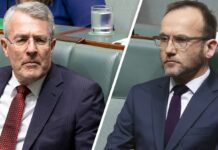Originally published at Occidental Observer.
As the vote on the Indigenous Voice to Parliament referendum looms, Australian dissidents and other supporters of White Australia should also begin casting their eyes to the next item on the left-wing constitutional amendment agenda: a second referendum on whether Australia’s constitutional ties to the British monarchy should be severed. Prime Minister Albanese publicly poured cold water on a republic move in the days after the death of Queens Elizabeth II, stating that the federal Labor government has no plan to pursue a referendum on the monarchy within the current term of office. Behind the scenes however, moves are being made to prepare the groundwork for another referendum push. The result of the failed referendum in 1999 has shown once again that a democratic vote in support of a change desired by progressives is binding, but a democratic vote against is merely a temporary setback to be overcome at a later date.
In June 2022, just months before the death of the Queen, Federal MP Matt Thistlethwaite was appointed to the newly created position of Assistant Minister for the Republic, a role dedicated to officially campaigning for an Australian republic on behalf of the government. The Reserve Bank of Australia decided, without much outcry, that King Charles III would not replace Elizabeth II on future Australian $5 banknotes. Then in October 2022, the Australian Republican Movement (ARM), a nationwide campaign group first formed in 1991, elected a fresh group of directors, led by former soccer player and refugee activist Craig Foster.[1] The stalwarts of the ARM appear invigorated by the scandals of Princes Harry and Andrew and the passing of Elizabeth (and with her the weakening of the popularity of the institution she represented for 70 years), which has presented the perfect opportunity to renew the fight.
How should patriotic Australians approach the question of a republic? Certainly the debate is older than the formation of the country itself and there are no hard or fast rules on whether a defender of White Australia must necessarily be a Republican or a Monarchist. The recurrent split down the centre of pro-White activism in Australia over the years has always been between two broad camps. On the one side are those who favour a nativist republic and look towards an Australian ethnogenesis and a new national identity that has, with geographical distance and the arrival of non-British White migrants, evolved away from its strict Anglo-Celtic origins. On the other are those who side with the monarchy and highlight the “necessity of Britishness” and British race patriotism in the construction and maintenance of Australia’s identity, that Australia is but an extension of the history and culture of the British Isles.[2] Lest it get side-tracked by the above ethnicity debate, this essay contends only with how the broad racial principle or ideal of a White Australia (one that sits above questions of ethnicity) relates to a position on the republic question.
Delving into Australia’s pre-Federation history, in the latter days of the colonies it was republicanism which once found strong association with the burgeoning cause for White Australia. The first large swell of fervour for an Australian republic came in tandem with the workers strikes and the economic upheaval of the late nineteenth century that spurred the growth of a radical nationalist and socialist movement, one ultimately leading to the formation of the Australian Labor Party. Republicanism swam with a political current that clamoured for national manhood through some form of independence from the Crown, and was resolutely opposed to Chinese immigration and the importation of cheap Pacific Islander labourers. The fear that British imperial policy, in particular in matters affecting immigration, was no longer wholly in-line with the interests of native Australians was a common refrain.

…all men who leave the tyrant-ridden lands of Europe for freedom of speech and right of personal liberty are Australians before they set foot on the ship which brings them hither. Those who fly from an odious military conscription; those who leave their fatherland because they cannot swallow the worm-eaten lie of the divine right of kings to murder peasants, are Australians by instinct—Australian and Republican are synonymous. No nigger, no Chinaman, no lascar, no kanaka, no purveyor of cheap coloured labour, is an Australian.[4]
A string of republican magazines and associations cropped up across the country proclaiming the inevitable arrival of a republic (a tradition continued to this day[5]), and among those enthralled by the fervour in Sydney was the young poet Henry Lawson, whose famous poem Song of the Republic appeared a few months later in The Bulletin:
Sons of the South, make choice between
(Sons of the South, choose true),
The Land of Morn and the Land of E’en,
The Old Dead Tree and the Young Tree Green,
The Land that belongs to the lord and the Queen,
And the Land that belongs to you.
A strong republican sentiment reared its head again in 1972 with the election of the Whitlam Labor government and reached a climax in the aftermath of the constitutional crisis known as the Dismissal. On November 11, 1975, the Governor-General Sir John Kerr, the Queen’s representative in Australia, had taken the drastic step of using his reserve powers to dismiss the Whitlam Labor government from office, in order to resolve a parliamentary deadlock that had created a loss of supply. The exact role played by the British royal family in the constitutional crisis is still up for debate, but the Dismissal invigorated a generation of Labor leaders, leading to Prime Minister Paul Keating’s unsuccessful republic push in the 1990s.
What I seek to sketch out in this essay is that, given the current state of the country, defenders of White Australia — whether they be Anglo or Nativist — would be wise to hold to the side of constitutional monarchy, irrespective of any historical alignment republicanism has had with White Australia. Many Australian nationalists who considered the issue in the leadup to the 1999 referendum came to similar conclusions, but the situation has devolved further over the last quarter-century and calls for another stocktake of the nation of sorts.
This conclusion is not derived from any particular sentiment in favour of the British Monarchy itself or any delusional belief that the royal family is somehow a supporter of White Australia. Instead, it comes from the recognition of the fact that the current republic alterative on offer will leave the country worse off and is not being pursed on terms that are acceptable to the maintenance of the principle of White Australia. Should the political conditions of Australia change, it may well be that republicanism can, as it did in the nineteenth century, find co-existence with White Australia. Furthermore, should the monarchy itself expire in the UK, a republic may simply become an administrative necessity devoid of any symbolic change. But as it stands now, with the monarchy still firmly in place in the UK, an Australian republic is a poisoned chalice that should be spurned.
The Republic as Political Asset
Two key questions provide us the framework for making this decision. The first question to ask is a more technical one; will becoming a republic improve the Australian political system and/or make the defence of White Australia an easier task politically?
As modern-day monarchists often point out, history shows us that there is nothing axiomatically beneficial about casting aside a constitutional monarch and becoming a republic. It does not overnight turn your country into a more successful or cohesive nation, and there is strong reason to suggest that a constitutional monarchy is a more politically stable arrangement. In such countries, wilder democratic passions can find an outlet only in the legislature — a place where parliamentary convention, the need for compromise, and the presence of an opposition tends to temper the intensity of the demands of voters — and ultimate power or the trappings of royal pomp and presidential status are always out of reach of an upstart despot or demagogue.
List the names of some of the most highly developed, peaceful and politically stable countries in the world — Sweden, Norway, Denmark, the Netherlands, Luxembourg, Japan, Canada, New Zealand and Australia itself — and you will find they are all constitutional monarchies. Likewise, if you had to pick the most politicly divided and chaotically multi-racial countries in the West right now, you would have to pick the USA and France, the birthplaces of modern republicanism. Historical and modern-day tyrannies also tend to bear the name republic: the USSR, the German Democratic Republic, the Democratic People’s Republic of Korea, and the People’s Republic of China. Of course, republics exist amongst the ranks of the highly developed, such as Iceland or Finland, though these tend to be parliamentary republics — recent converts to republicanism after long histories of monarchy, where the president is as ceremonial as a constitutional monarch and there is no real possibility of him or her coming into conflict with the legislature.
As regarding republicanism specifically in the defence of White Australia, the benefits also remain elusive. Historically, the racially conscious republicanism of the late nineteenth century quickly dissipated in favour of the realisation that national pride could peacefully co-exist with British imperial pride, and that White Australia was safer from Japan and the “rising tide of colour” within the Empire than without. Constitutional monarchy and the Westminster System of government turned out to be no significant impediment on the adoption of the White Australia Policy in 1901. The Policy was assented to over protests from the British government, and with the right government in charge again, it can be re-adopted by parliament just the same.
Nor is it possible to envisage how a republic could have succeeded in saving White Australia in the 1960s and 1970s where possession of a strong presidential republic failed to avert a similar outcome in America. Neither multiculturalism nor multiracialism were implemented in Australia via a democratic process that could have been opposed democratically. Instead, both outcomes were accomplished by stealth, in a form of elite (substantially Jewish) conspiracy carried out in the depths of the Australian bureaucracy, using “salami-slice” or “thin-edge-of-the-wedge” tactics that would have left voters in a hypothetical Australian republic just as much in the dark.
Furthermore, if the minimalist republican model presented to voters in 1999 had been implemented, a ceremonial position whereby a candidate would be exclusively chosen by the Prime Minister of the day, the Australian president would have no more power to arrest the current demographic situation than the Governor-General currently does. The new Australia Choice Model of a republic developed by the ARM for use in a new referendum would fare no better. Even if given significant executive powers, a president elected by the Australian people with a popular mandate to end multiculturalism would still be impotent against an oppositional legislature, or cause political chaos at best. Ultimately, in the Australian political system, power to affect Australia’s cultural and racial makeup lies with the legislature and hopes for a political revival of White Australia must be focused on that body alone.
The Republic as Symbolic Act
This leads us to the second and far more important question. If becoming a republic does not benefit White Australia in the sense of the country’s political structure, then benefits of its adoption lie solely in rhetoric or symbolism, with a cultural argument that puts forth a statement of Australia’s destiny. In that case, what is the current symbolic positioning for the creation of an Australian republic?
For the longest time, mainstream supporters of a republic defended it as an egalitarian patriotic cause allied with nationalism, and believed it symbolised a positive identity for Australia’s future, not a violent break with its British past. To them, a republic was the pronouncement of an Australia that wanted to show the world it was an independent nation-state that could now go along without the ties to the motherland. The direct British connection was seen as a colonial leftover, an obstacle to the development of a truly Australian national identity, and once cast aside, the country could pursue its own place in the world with a born-and-bred Australian, not a foreign monarch, occupying the role of head of state. The popular imagery of republican arguments was one of filial affection, a mutually beneficial departure from the home by a child that had now reached adulthood and wanted to function on its own terms, and the parent that knew at some point it had to let the child leave the nest in order to grow. Republicanism of this type is perfectly consistent with the principle of White Australia and offers no barrier, in symbolic terms, to its conservation and continuance.
This twentieth-century republican sentiment, prefigured by the writings of nationalist P.R. Stephensen in the 1930s and moulded later by prominent voices such as Donald Horne and Geoffrey Dutton[6], still held true for the majority of republic-supporting voters in the 1999 referendum, and was the main symbolic argument presented to the voting public by the campaign, but there was another type of sentiment at play then too. This alternative sentiment had germinated amongst the cultural revolutionaries in the 1960s but was still hidden in the background in the leadup to the referendum for fear of needlessly jeopardising the Yes vote. Though subtle, both nationalists and monarchists identified the link between Keating’s republicanism and the ascendant multiculturalist ideology which sought greater enmeshment in Asia and indigenous reconciliation.
In the years since, the “multicultural republic” sentiment has mutated beyond even the worst fears of patriots and has come to the fore to be the dominant positioning of republican sentiment in the country, the one publicly held by the leaders of the ARM and espoused by the media, academic and political elite who speak for the republican case. If the republic campaign is launched today, it is this sentiment, not the old one, that will drive the debate and animate the discussions of its supporters, and be the one that would ultimately carry a victory.
This is the republicanism borne not out of love for Australia, but out of hatred. A republicanism that, whilst retaining its original egalitarianism and desire for a local-born head of state, has almost nothing to do with national unity, patriotism, or a sense of pride in Australia and its unique history as a European country on the other side of the planet. Instead, it is driven by a destructive anti-White impulse, one that seeks to sever the ties with Britain as a way of immunising the country from the moral contagion of colonialism and slavery and all the other racial ills lain now at the foot of the British Empire and Western Civilisation as a whole. It is a republicanism borne out of rejection of Australia’s racial, political and cultural origins in Britain and wider Europe; articulated in the loathing of the fact that Australia’s head of state is an “old white man,” and the aggrieved realisation that unless multiple royals in the line of succession die early deaths, it will continue to be an old White man for at least the next 70 years.

In this form of self-flagellating republicanism, Australia’s inheritance from Britain is not something to cherish and value, but something to scorn or destroy. References are always made to the supposedly detrimental impact of the monarchy and the British connection on “first nations people”, and the words “modern” and “multicultural” are always present on the lips of these types of republicans, as it was when Minister for the Republic Matt Thistlethwaite recently appeared on the television program QandA:
But over the longer term, we see Australia as a mature, independent nation, making its own way in the world, reflecting our true multiculturalism, our unique culture and identity by having one of our own as our head of state in the future.[7]
Craig Foster, the leader of the ARM, appearing on the same program a few months earlier, went a step further and made the case that the push for the republic is an integral part of the “decolonisation” of Australia:
The answer for Australia is yes, and it has been for some time. And so, overwhelmingly, the research says that Australians are in favour of…decolonisation, really, and this is one part of it. That’s another part of it, right? Decolonisation of thinking and moving and walking together [8]
For academics and leading public intellectuals who speak on the debate[9], the issue has become overwhelmingly enmeshed with the ‘Black Armband’ view of history, arguing that a republic has no moral or symbolic weight unless it is combined with the push for indigenous reconciliation. For prominent republican scholar Mark Mckenna, this means that a republic has to be based on “an entirely different conception of Australian independence”, one that re-writes Australia’s history and grounds it not on British settlement but on “thousands of generations of Indigenous occupation”.[10] Another republican, Dennis Altman, contends that:
A republican movement that begins with the Uluru Statement from the Heart[11], rather than concerns about the symbolic links to the British crown, is a project more likely to capture the imagination of Australians.[12]
Elsewhere, Federal Greens Senator Mehreen Faruqi, a Pakistani-born migrant, has no fear in publicly declaring the British Monarchy to be a “racist, colonial institution”[13] and that the death of the Queen is a reminder for Australians of the urgency of becoming a republic and of carrying out reconciliation.
If the Australian republic is to be pursued for symbolic reasons, then the first act of symbolism that would be pursed under a new “decolonised” and “indigenously reconciled” Australian republic should be now clear to us — the first Australian president (or whichever title it ends up being) must not be an “old white man.” The person chosen will almost certainly be some sort of intersectionality concoction; perhaps a disabled Aboriginal woman, a transgender Asian man, or a Jewish Lesbian.
Whatever the eventual combination, this new president will be hailed as a symbol to the world that White Australia is on its way out and that the new multi-racial Australian republic has succeeded it. His or her speeches will surely be replete with references to the success of multiculturalism and a racially diverse Australia with 60,000 years of history, and the need to correct the alleged genocidal dispossession of First Nations people by Australia’s illegitimate founders. Would-be migrants from around the world will take it as a sign of a conquered nation where the White man is no longer in control of his destiny.
So long as Australia remains a constitutional monarchy and it is King Charles III, King William V, or King George VII that sit on the throne as Australia’s Head of State, White Australia is spared this indignity and this symbolic vanquishment. If Australia is to become a republic, it must be done on terms that are acceptable to and compatible with the nation’s foundational principle of White Australia, even if this means the “inevitable” republic must wait for another century.
Originally published at Occidental Observer.
[1] Also on the new executive board is long-time multicultural activist Vic Alhadeff, the former CEO of the New South Wales Jewish Board of Deputies.
[2] See the article “Revolt of the Anglophiles” by Australia First Party leader Jim Saleam, where Alan James and The Occidental Observer contributor Andrew Fraser intervene in the comments section. A similar dynamic could be seen between Australia’s two most prominent patriotic historians, the republican Manning Clark and the constitutional monarchist Geoffrey Blainey — J. Saleam 2013, ‘The Revolt of the Anglophiles: The New Political Anglos & Frank Salter’s Deconstruction of Australianity’, Counter Currents, December 26, retrieved from: https://counter-currents.com/2013/12/the-revolt-of-the-anglophiles
[3] The Bulletin 1888, The Imperial Connection, Saturday 14 April, p.10, retrieved from: https://nla.gov.au/nla.obj-706788911/view?partId=nla.obj-706792675
[4] The Bulletin 1887, Australia for the Australians, Saturday 2 July, p.4, retrieved: from https://nla.gov.au/nla.obj-693332894/view?partId=nla.obj-746241180
[5] The notion of “inevitability” has ironically enough long since been a detriment to the republican case, with successive republicans citing the inevitability of an Australian republic as a reason why it is a change that should not be vigorously or urgently pursued – See: M. Mckenna 1996, The Captive Republic: A History of Republicanism in Australia 1788–1996, Cambridge University Press, New York.
[6] Anti-racist undertones were present in the writings of both Horne and Dutton, though its impact on their republican arguments was limited.
[7] QandA – Words That Offend and Referendums 2023, television broadcast, 6 March, Australian Broadcasting Corporation, Sydney, Australia, transcript retrieved from: https://www.abc.net.au/qanda/2023-06-03/102019930
[8] QandA – The Year of the Voice 2023, television broadcast, 30 January, Australian Broadcasting Corporation, Sydney, Australia, transcript retrieved from: https://www.abc.net.au/qanda/2023-30-01/101868690
[9] See Jones. B T & McKenna. M 2013, Project republic: plans and arguments for a new Australia, (B. T. Jones & M. McKenna, Eds.), Black Incorporated, Collingwood, Australia.
[10] M. McKenna 2021, ‘The Stunted Country’, The Monthly, Dec 2021-Jan 2022 Issue, retrieved from: https://www.themonthly.com.au/issue/2021/december/1638277200/mark-mckenna/stunted-country#mtr
[11] A statement of principles derived from the Final Report of the Referendum Council in 2015, which recommended a constitutional amendment to enshrine an ‘Indigenous Voice to Parliament. ‘ The referendum council was co-chaired by Australia’s leading Jewish activist Mark Leibler.
[12] D. Altman 2022, ‘The republic debate is back (again) but we need more than a model to capture Australians’ imagination’, The Conversation, January 19, retrieved from: https://theconversation.com/the-republic-debate-is-back-again-but-we-need-more-than-a-model-to-capture-australians-imagination-175058
[13] M. Faruqi 2022, ‘There’s nothing to celebrate about the British Monarchy, The Greens Magazine, 25 March, retrieved from: https://greens.org.au/magazine/theres-nothing-celebrate-about-british-monarchy



